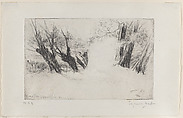The Lovers' Walk, No. 1
Sir Francis Seymour Haden British
Not on view
Seymour Haden was the unlikely combination of a surgeon and an etcher. Although he pursued a very successful medical career, he is mostly remembered for his etched work as well as for his writings on etching. He was one of a group of artists, including James McNeill Whistler (1834–1903) and Alphonse Legros (1837–1911), whose passionate interest in the medium led to the so-called etching revival, a period that lasted well into the twentieth century. The extolling of etching for its inherent spontaneous qualities reached its pinnacle during this time. While the line of the etching needle, Haden wrote, was "free, expressive, full of vivacity," that of the burin was "cold, constrained, uninteresting," and "without identity."
View of tree trunks with a small space left blank at center; empty foreground; high grass at left middle ground.
"State III. The center distance completely removed."
[Source: Schneiderman, p. 169 ]
"Trial Proofs: (a) The tree stems are alone indicated, and the willows throw shadows towards the right. 'Thames Ditton, Seymour Haden 1864.' Coll. H."
[Source: Harrington, p. 35]
Due to rights restrictions, this image cannot be enlarged, viewed at full screen, or downloaded.


